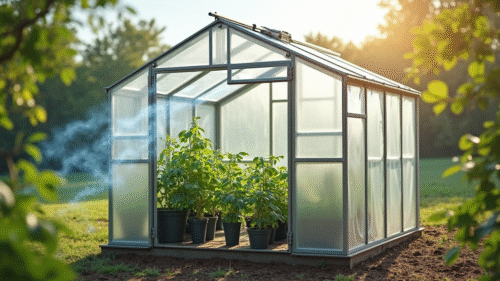
Understanding Ventilation In Compact Greenhouses
Understanding Ventilation in Compact Greenhouses is essential for any gardener aiming to maintain a healthy, productive environment in a limited space. Proper airflow controls temperature, reduces humidity, and helps prevent the buildup of mold, mildew, and plant diseases — all common issues in small, enclosed greenhouse setups. Whether you’re growing herbs on a patio or tending seedlings in a backyard unit, understanding the principles of greenhouse ventilation can make the difference between thriving plants and frustrating failures. In this guide, we’ll explore the importance of ventilation, types of systems available, and how to optimize airflow even in the most space-constrained designs.
If you’re setting up a compact greenhouse in your backyard like I did, figuring out how to handle airflow can be confusing at first. The air inside can get hot and humid, and plants can really struggle if things aren’t balanced. You want your seedlings and veggies to grow strong, but it’s easy to get tripped up with vents, fans, and airflow — especially in a tight space.
Airflow in a small greenhouse is a big deal for plant health. If the air isn’t moving right, you’ll see issues like overheating, weak stems, fungal diseases, and poor growth. I learned the hard way that just cracking a window or throwing open a door once in a while doesn’t really fix the problem. There’s a bit more to it, and getting it dialed in makes gardening a lot easier, not to mention more fun.
Why Compact Greenhouses Need Proper Airflow
Many new greenhouse owners skip the importance of greenhouse ventilation at first. I used to think my mini greenhouse was fine since it wasn’t that big, but the reality is small greenhouses heat up even faster than their larger cousins. The sun’s rays can push temps sky-high in just minutes, while humidity can soar with just a bit of morning watering.
Why ventilation matters:
- Stale, damp air encourages mold and fungi, like powdery mildew and botrytis—they love warm, muggy spaces.
- Poor air movement leads to weak, leggy plants and poor pollination.
- Many pests thrive in stuffy conditions.
- Stressed plants are more likely to drop leaves or abort fruit.
Passive ventilation or moving air also keeps the temperature and humidity balanced. That’s really important if you want your compact greenhouse to stay productive all season.
As an Amazon Associate, I earn from qualifying purchases
How Much Airflow Does a Small Greenhouse Really Need?
When I was checking out greenhouse setups, I wanted a straight answer: how much is enough for a smaller structure? The short version: aim for vents equal to about 20% of your greenhouse floor area. If you have a 6×8-foot greenhouse (48 square feet), try to have a total vent area of around 9-10 square feet. That seems like a lot, but even partially open vents help during hot spells.
For very small or shelf style greenhouses, you might only have adjustable roof and front vents. That’s fine—the important part is to maximize the amount of air you can change out on a sunny day. Having vents at both the bottom and top gives you the best airflow, pulling in cool air low and letting hot air out the roof.
For my own mini greenhouse, I keep two roof panels slightly open most of the day and open the door partway as needed. It’s a quick adjustment, but I see a huge difference in plant growth and leaf color.
Should Vents Be Open or Closed on a Mini Greenhouse?
This was a big question for me when I was starting out. The answer depends on the weather and your plants. The main thing to remember is when the sun is shining, temperature can spike fast — way more quickly than outdoors.
During the day (especially spring through fall), it’s usually better to keep vents at least partly open. On warm, sunny days, I leave both roof and side vents wide open, so the air doesn’t stagnate. For frosty nights or cold days, I shut the vents in the late afternoon to trap heat. If you’re starting seeds or growing tender plants, just check the temperature with a basic thermometer. You’ll soon get a feel for when to open or close things.
Pro tip: If your greenhouse still heats up too much, even with vents open, you can prop open the door for a few hours or set up a small fan to help move air. Just keeping some good airflow works wonders; plants don’t like hot, stuffy, stalled air.
How Airflow Works Inside a Greenhouse
The basic idea is all about swapping inside air for outside air. Warm air rises, so when you’ve got roof vents or even a window up top, heated air escapes there. Cooler air gets pulled in through lower vents, creating circulation. This natural movement is called passive airflow, and most compact greenhouses depend on this (unless you’re adding a fan setup).
For really small spaces, it doesn’t take much to move the air, but things need to be set up right. With vents only on one side, fresh air might not make it all the way through your shelves. That’s why placing vents opposite each other—like one low and one up high, or on opposite ends—helps you avoid dead spots with still, muggy air.
I usually check the inside on warmer days by standing inside and just seeing if I feel a breeze. Even a little air movement you can fee — just a hint — is enough to keep your plants in good shape.
Tips to Get Air Moving in a Small Greenhouse
Getting air to actually move in a compact greenhouse can be tricky. Sometimes passive vents aren’t enough, especially if your space is packed with seed trays, pots, and hanging plants. Here’s what’s helped me:
- Open both top and bottom vents: This creates a natural flow — cool air in low, warm air out high.
- Use a small clip-on or oscillating fan: Just one lightweight fan set on low keeps air shifting around, which helps keep mold problems away.
- Arrange plants with some gaps: Don’t jam everything together; leave a bit of space so air can move between the leaves. Your plants will thank you for it.
- Leave the door open a bit when temps allow: Even a few inches can make a difference.
If you want to get a little more advanced, adding automatic vent openers — a temperature-sensitive piston that opens or closes the vent as it warms up — can save you from constantly adjusting things by hand.
Extra Tips for Common Airflow Problems
Dealing with Humidity Swings
Humidity jumps fast after watering. If you find your greenhouse windows fogging up or condensation dripping, it’s time to start managing humidity by opening things up. Running a fan for half an hour after watering can get rid of that extra moisture quickly and help with preventing mold.
Pest and Disease Prevention
Most greenhouse pests — such as aphids and whiteflies — love stagnant air. Fungal problems almost always show up if air isn’t moving. Checking airflow often and spacing out your plants help you avoid these headaches.
My Experience with Compact Greenhouse Airflow
I bought my first 6x4foot greenhouse to try growing tomatoes early in the season. At first, I thought airflow was just for summer, so I left everything closed on chilly days to “trap heat.” By mid-spring, my plants had mildew and looked pretty sad — even though they had enough water and nutrients.
After opening the vents on every sunny day (no matter how cool it felt outside), things changed. My seedlings grew faster, my tomatoes toughened up, and I didn’t have to fight mold as much. I even set up a basic thermometer and hygrometer to check on the temperature and humidity — I definitely recommend this for anyone with a mini greenhouse.
Once you figure out a routine and watch how your plants react, greenhouse gardening gets much more relaxed. Airflow isn’t complicated, it just takes a little attention. With the right routine, your small greenhouse can be a productive, healthy spot for growing all year long.
For folks just starting out, remember… managing airflow is key in a small greenhouse. Keep an eye on the temps, use your vents, don’t crowd your plants, and enjoy the difference it makes.
✅ ** Conclusion:
Ventilation isn’t just a luxury in compact greenhouses — it’s essential for maintaining healthy plants, regulating temperature, and preventing disease. Whether you’re just starting out or refining your setup, take time to review our small-space greenhouses introduction and understand how greenhouse size affects airflow. Don’t overlook helpful tools featured in our guide to essential gardening tools, which can make a major difference in climate control. Long-term success depends on routine upkeep, so follow our tips for maintaining your small greenhouse, and be sure to avoid key mistakes in small-space greenhouses that restrict air circulation. Finally, your greenhouse materials matter — discover how your choice of structure can impact airflow. With smart planning and consistent ventilation, your compact greenhouse can thrive in any season.

Leave a Reply